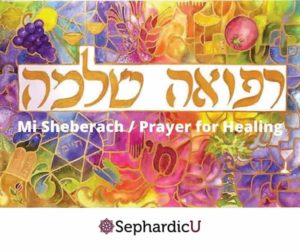
Join us for daily virtual minyanim rooted in Sephardic tradition and inclusive community.

Sephardic U Calendar

Joining Sephardic U’s virtual minyan can be an excellent way to fulfill your spiritual needs while staying connected to a Jewish community. With the rise of online platforms and video conferencing tools, it has never been easier to participate in a virtual minyan from the comfort of your own home, office or on the road.
By joining our virtual minyan, you can take advantage of the many benefits that come with group prayer, including a sense of unity and communal support. You’ll also have the opportunity to connect with fellow worshippers from all over the world, expanding your network and building lasting relationships.
Whether you’re unable to attend in-person services or simply looking for a more convenient way to participate, a virtual minyan can be a valuable addition to your spiritual practice. So why wait? Join our virtual minyan today and experience the many benefits for yourself!
A virtual minyan is a group of people who come together for prayer, study, or other Jewish communal activities through an online platform. The word “minyan” refers to the traditional quorum of ten Jewish adults required for certain prayer services and other religious rituals.
In the context of a virtual minyan, participants can join from anywhere in the world using video conferencing tools like Zoom or Skype. Virtual minyanim have become increasingly popular in recent years, especially among those who are unable to attend in-person services due to geographical, physical, or other limitations.
While virtual minyanim cannot fully replace the experience of in-person prayer, they offer a valuable alternative for those who wish to stay connected to their Jewish community and maintain their spiritual practice.
A virtual minyan, or a prayer gathering conducted through an online platform, offers many benefits to those who wish to participate in communal worship. In this essay, we will explore some of the key benefits of a virtual minyan and why it may be a beneficial option for individuals seeking to connect with their faith community.
Accessibility: A virtual minyan allows individuals who may not have access to a physical minyan due to geographical or physical barriers to participate in communal prayer. Whether someone is homebound, living in a remote area, or traveling, a virtual minyan enables them to connect with their faith community and participate in communal worship. This level of accessibility is especially important for individuals with mobility issues or those who are unable to travel to a physical minyan.
Inclusivity: Virtual minyanim promote inclusivity by providing a more welcoming environment for individuals who may not feel comfortable in traditional minyanim due to factors such as gender, sexual orientation, or religious practice. Virtual minyanim allow for more open communication and interaction, and can foster a sense of community and belonging for all participants.
Flexibility: Virtual minyanim can be held at different times and locations to accommodate the schedules of participants. This level of flexibility makes it easier for individuals to participate in communal prayer, as they can choose a time that works best for them. This can encourage more individuals to participate in prayer and can help build a stronger sense of community among participants.
Innovation: A virtual minyan provides an opportunity for innovative approaches to prayer and worship. By using technology, virtual minyanim can create a more engaging and interactive worship experience, using multimedia elements such as virtual backgrounds, music, and interactive features. This can enhance the spiritual experience of participants and provide a fresh perspective on traditional prayer practices.
Resilience: Virtual minyanim offer a means of maintaining a sense of community and continuity during times of crisis or uncertainty, such as during a pandemic, when physical gatherings may not be possible. Virtual minyanim enable individuals to maintain their connection to their faith community and engage in communal worship even during challenging times, providing comfort and support for participants.
In conclusion, a virtual minyan offers many benefits to individuals seeking to connect with their faith community and participate in communal worship. From accessibility to inclusivity, flexibility, innovation, and resilience, a virtual minyan provides a meaningful and enriching experience for participants. Whether you are unable to attend a physical minyan or are seeking a more inclusive and engaging worship experience, a virtual minyan may be the perfect solution for you.
Sephardic Jewry is inclusive in its approach to Jewish life, recognizing and embracing the diversity of the Jewish people. Sephardic Jews have a long history of living in and interacting with different cultures and communities, and this has influenced their approach to Judaism in a number of ways.
One aspect of Sephardic inclusivity is linguistic. Sephardic Jews have developed a rich tradition of Jewish literature and prayer in a variety of languages, including Hebrew, Ladino, Arabic, and other local languages. This diversity of language reflects the diversity of the Sephardic world and allows for a broader range of people to connect with Jewish texts and traditions.
Another aspect of Sephardic inclusivity is cultural. Sephardic Jews have a unique blend of Jewish and non-Jewish cultural traditions that are integrated into their practice of Judaism. These traditions include music, food, and art, which are often shared and enjoyed by both Sephardic and non-Sephardic Jews.
Sephardic inclusivity also extends to the role of women in the community. While Sephardic halakha generally follows traditional gender roles, Sephardic communities have a long history of empowering women to take on leadership roles and play active roles in the community.
Overall, Sephardic inclusivity is about creating a space where everyone, regardless of their background or beliefs, feels welcome and valued within the Jewish community. It is about recognizing and embracing the diversity that exists within the Jewish people and using it to create a vibrant and inclusive community.
According to Jewish law and tradition, there are differing opinions on the permissibility of a virtual minyan.
Some rabbis and halakhic authorities argue that a virtual minyan is permissible because the essence of a minyan is the gathering of ten individuals for the purpose of prayer and communal worship, regardless of their physical location. They argue that since virtual minyanim allow for the gathering of ten individuals for prayer and worship, they fulfill the requirement for a minyan.
Other rabbis and halakhic authorities, however, argue that a virtual minyan is not permissible because a minyan requires a physical gathering of ten individuals in the same space. They argue that the use of technology to facilitate a virtual gathering is not sufficient to fulfill the requirements of a minyan.
It is important to note that the permissibility of a virtual minyan may vary depending on the circumstances and context in which it is being conducted. Some rabbis may permit a virtual minyan in certain situations, such as during a pandemic when physical gatherings may not be possible, while others may not permit it under any circumstances.
Ultimately, the decision to participate in a virtual minyan should be made in consultation with one’s rabbi or halakhic authority, based on their individual beliefs and interpretations of Jewish law and tradition.
The philosophy of Sephardic Jewry is a rich and diverse set of beliefs, values, and practices that have developed over centuries of Jewish life in the Sephardic world. At its core, Sephardic philosophy emphasizes the integration of Jewish tradition with the broader cultural and intellectual currents of the surrounding society. Sephardic Jews have a deep respect for knowledge and education, and view the pursuit of wisdom and understanding as an essential part of their religious and intellectual heritage.
Sephardic philosophy also places a strong emphasis on communal life and social justice. Sephardic Jews believe in the importance of building strong and vibrant communities, and in working to improve the world around them through acts of kindness, charity, and tikkun olam (repairing the world).
Another important aspect of Sephardic philosophy is the centrality of Sephardic halakha (Jewish law) and the guidance of Sephardic rabbis. Sephardic Jews place great importance on the teachings of their rabbis, who provide guidance and support in all aspects of Jewish life.
Overall, the philosophy of Sephardic Jewry is a dynamic and evolving tradition that is rooted in the wisdom and experience of generations of Sephardic Jews. It combines a deep respect for tradition with a willingness to engage with the wider world, and reflects the values of compassion, justice, and community that are central to the Jewish faith.
Shacharit (morning service) ~30 minutes
Join us via Zoom each weekday morning for Shacharit services. If you have them, bring your tefillin and tallit. You can follow along online or with our siddur. Services begin promptly and take about 30 minutes.
Torah reading – We read the Torah during Shacharit (morning) services, each Monday, Thursday and Rosh Hodesh (the new month). If you’d like to participate or have an Aliyah, please fill out our Prayer Request form.
Arvit (evening service) ~15 minutes
Wind down your weekday and Sunday evenings and join us for Arvit prayer service. Prayers only take 15 minutes.
.בָּרְכוּ אֶת יְהֹוָה הַמְּבֹרָךְ .בָּרוּךְ יְהֹוָה הַמְּבֹרָךְ לְעוֹלָם וָעֶד .בָּרוּךְ יְהֹוָה הַמְּבֹרָךְ לְעוֹלָם וָעֶד
בָּרוּךְ אַתָּה יְהֹוָה, אֱלֹהֵינוּ מֶלֶךְ הָעוֹלָם, אֲשֶׁר בָּחַר בָּנוּ מִכָּל הָעַמִּים וְנָתַן לָנוּ אֶת תּוֹרָתוֹ. בָּרוּךְ אַתָּה יְהֹוָה, נוֹתֵן הַתּוֹרָה: אמן.
גֹּאֲלֵ֕נוּ יְהֹוָ֥ה צְבָא֖וֹת שְׁמ֑וֹ קְד֖וֹשׁ יִשְׂרָאֵֽל׃
וְזֹ֖את הַתּוֹרָ֑ה אֲשֶׁר־שָׂ֣ם מֹשֶׁ֔ה לִפְנֵ֖י בְּנֵ֥י יִשְׂרָאֵֽל׃ תּוֹרָ֥ה צִוָּה־לָ֖נוּ מֹשֶׁ֑ה מוֹרָשָׁ֖ה קְהִלַּ֥ת יַעֲקֹֽב׃ הָאֵל֮ תָּמִ֢ים דַּ֫רְכּ֥וֹ אִמְרַֽת־יְהֹוָ֥ה צְרוּפָ֑ה מָגֵ֥ן ה֝֗וּא לְכֹ֤ל ׀ הַחֹסִ֬ים בּֽוֹ׃
Mi Sheberach, the Jewish prayer for healing, is one of the most meaningful prayers in Judaism. It is a public prayer or blessing for an individual or group, most often recited in synagogue when the Torah is being read.
מִי שֶׁבֵּרַךְ אֲבוֹתֵינוּ אַבְרָהָם יִצְחָק וְיַעֲקֹב מֹשֶׁה וְאַהֲרֹן דָּוִד וּשְׁלֹמֹה הוּא יְבָרֵךְ וִירַפֵּא אֶת (father’s name) בן (name), הַקָּדוֹשׁ בָּרוּךְ הוּא יִמָּלֵּא רַחֲמִים עָלָיו לְהַחֲלִימוֹ וּלְרַפְּאֹתוֹ וּלְהַחֲזִיקוֹ וּלְהַחֲיוֹתוֹ, וְיִשְׁלַח לוֹ מְהֵרָה רְפוּאָה שְׁלֵמָה מִן הַשָּׁמַיִם לְרַמַ”ח אֵבָרָיו וּשְׁסָ”ה גִּידָיו בְּתוֹךְ שְׁאָר חוֹלֵי יִשְׂרָאֵל, רְפוּאַת הַנֶּפֶשׁ וּרְפוּאַת הַגּוּף, הַשְׁתָּא בַּעֲגָלָא וּבִזְמַן קָרִיב. וְנֹאמַר אָמֵן.
בָּרוּךְ אַתָּה ה’ אֱלֹהֵינוּ מֶלֶךְ הָעוֹלָם הַגּוֹמֵל לְחַיָּבִים טוֹבוֹת שֶׁגְּמָלַנִי כָּל טוֹב.
מִי שֶׁגְמַלְךָ כֹּל טוֹב הוּא יִגְמַלְךָ כֹּל טוֹב סֶלָה.
Tefilat HaDerech (Hebrew: תפילת הדרך), also known as the Traveler’s Prayer or Wayfarer’s Prayer in English, is a prayer for safe travel recited by Jews when traveling by air, sea, or long car trips. It is recited at the start of every journey, preferably standing, but this is not required. It is frequently inscribed on hamsas, which may also include the Shema or Birkat HaBayit prayer.
| Name | Symbol | Sephardi |
|---|---|---|
| Sof passuk | ב׃ | סוֹף פָּסֽוּק Sof pasuk |
| Etnachta | ב֑ | אַתְנָ֑ח Atnaḥ |
| Segol | ב֒ | סְגוֹלְתָּא֒ Segolta |
| Shalshelet | ב֓ | שַׁלְשֶׁ֓לֶת Šalšeleþ |
| Zakef katan | ב֔ | זָקֵף קָט֔וֹן Záqéf Qáţown |
| Zakef gadol | ב֕ | זָקֵף גָּד֕וֹל Záqéf Ggádowl |
| Tifcha | ב֖ | טַרְחָ֖א Tarḥa |
| Rivia | ב֗ | רְבִ֗יע Revia |
| Zarka | ב֮ | זַרְקָא֮ Zarqa |
| Pashta | ב֙ | קַדְמָא֙ Qadma |
| Shene pashtin | ב֨ב֙ | תְּרֵ֨י קַדְמִין֙ Tere qadmin |
| Yetiv | ב֚ | יְ֚תִיב Yetiv |
| Tevir | ב֛ | תְּבִ֛יר Tviyr |
| Pazer | ב֡ | פָּזֶר גָּד֡וֹל Pazer gadol |
| Qarne farah | ב֟ | קַרְנֵי פָרָ֟ה Qarne farah |
| Telisha gedola | ב֠ | תִּ֠רְצָה Tirtzah |
| Geresh | ב֜ | גְּרִ֜ישׁ Gerish |
| Gershayim | ב֞ | שְׁנֵי גְרִישִׁ֞ין Shene gerishin |
| Munach | ב׀ | פָּסֵ֣ק׀ Paseq |
| Mercha | ב֥ | מַאֲרִ֥יךְ Maarich |
| Munach | ב֣ | שׁוֹפָר הוֹלֵ֣ךְ Shofar holech |
| Mahpach | ב֤ | (שׁוֹפָר) מְהֻפָּ֤ךְ (Shofar) mehuppach |
| Darga | ב֧ | דַּרְגָּ֧א Ddarggá |
| Kadma | ב֨ | אַזְלָ֨א or קַדְמָ֨א Azla or Qadma[18] |
| Telisha ketana | ב֩ | תַּלְשָׁא֩ Talsha |
| Mercha kefula | ב֦ | תְּרֵי טַעֲמֵ֦י Tere ta’ame |
| Yerach ben yomo | ב֪ | יֵרֶח בֶּן יוֹמ֪וֹ Yeraḥ ben yomo |
Spanish-Portuguese custom
זַרְקָא֮ מַקַּף־שׁוֹפָר־הוֹלֵ֣ךְ סְגוֹלְתָּא֒ פָּזֵר גָּד֡וֹל תַ֠לְשָׁא תִּ֩ילְשָׁא אַזְלָ֨א גֵּ֜רֵישׁ פָּסֵק ׀ רָבִ֗יעַ שְׁנֵי־גֵרֵישִׁ֞ין דַּרְגָ֧א תְּבִ֛יר מַאֲרִ֥יךְ טַרְחָ֖א אַתְנָ֑ח שׁוֹפָר־מְהֻפָּ֤ךְ קַדְמָא֙ תְּרֵ֨י־קַדְמִין֙ זָקֵף־קָט֔וֹן זָקֵף־גָּד֕וֹל שַׁלְשֶׁ֓לֶת תְּרֵי־טַעֲמֵ֦י יְ֚תִיב סוֹף־פָּסֽוּק׃

These comforting words can be said on behalf of those who are ill.

Add loved ones to the list and we will send you a reminder each year.

Feel free to download our siddur or follow along in Zoom.
ADVERTISEMENT

ADVERTISEMENT
Visually interact and learn about our nearly 6000 year history.
An interactive tour through our rich heritage spanning from 900 B.C.E.
Learn about our numbers, languages and population.
The greatest minds, philosophers and authors of their time.
Everything you wanted to know about Sephardic customs.
Learn our traditions for brit to marriage and bereavement.
Food is the universal thing that has the power to bring people together.
Listen to the rich repertory of Sephardi music and prayers.
Connect to our calendar for the latest events and happenings.
Read real-time updates as the relates to the Sephardic world.
We welcome you to join us virtually for Shacharit and Arvit.
Make new friends while expanding your mind. Quarterly. Join now.
View the full list of every Jewish holiday and observance.
Browse through our recommended reading list of over 100 books.
Download our guides to help you plan for the Holidays.
We welcome all in need of prayer, healing or Kaddish.
Get notified about new articles


Login to your account
Get notified about new articles